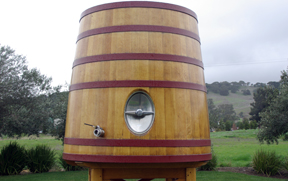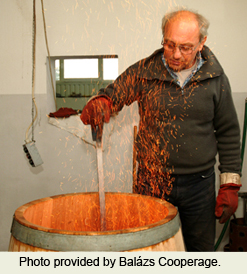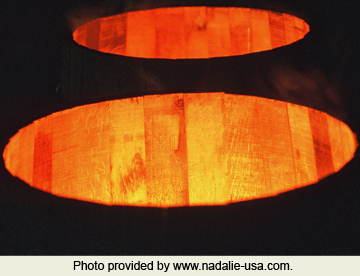Seguin Moreau Cooperage
b y
Terry Sullivan
 Summary: A large oak tank sits near the entrance to Seguin Moreau in Napa. Wine country not only includes the vineyards and wineries, but also those industries that support the making of wine. Barrels have been used in wine production for hundreds of years. The process hasn't changed much over time.
Summary: A large oak tank sits near the entrance to Seguin Moreau in Napa. Wine country not only includes the vineyards and wineries, but also those industries that support the making of wine. Barrels have been used in wine production for hundreds of years. The process hasn't changed much over time.
The process of barrel making is a thousand year-old craft. Wood from centuries-old forests are harvested and then cut and split into staves. The staves are left outside in the weather for three to four years. They are then brought to the cooperage where fire, water and force fit them together to form a barrel. Forests are planted today to be harvest hundreds of years from now.
 In the cooperage factory barrels are created. The first stop is the most amazing. Pits of fire on the floor are fed oak chips and unwanted oak scraps to keep the fires burning. Around the fires, wood staves, held by a metal circular form, slowly warm and slightly begin to bend. A cooper sprays water onto the wood and places a hoop around the wood staves and uses a mallet to force it down. This helps shape the barrel and fit the staves closely together.
In the cooperage factory barrels are created. The first stop is the most amazing. Pits of fire on the floor are fed oak chips and unwanted oak scraps to keep the fires burning. Around the fires, wood staves, held by a metal circular form, slowly warm and slightly begin to bend. A cooper sprays water onto the wood and places a hoop around the wood staves and uses a mallet to force it down. This helps shape the barrel and fit the staves closely together.
 Some barrels have a certain amount of toast added to the inside of the barrel. These barrels are placed over the fires and the cooper determines the degree of toast. It reminded me of placing bread in a toaster and watching it toast. The longer it is in the toaster the darker it becomes. We were entranced while watching this century-old process. The art of cooperage has changed little in thousands of years.
Some barrels have a certain amount of toast added to the inside of the barrel. These barrels are placed over the fires and the cooper determines the degree of toast. It reminded me of placing bread in a toaster and watching it toast. The longer it is in the toaster the darker it becomes. We were entranced while watching this century-old process. The art of cooperage has changed little in thousands of years.
The next section of the factory was an assembly line. The large room was bright with many workers at different stations along the line. It was a stark contrast to the first room that was darker with the orange glow of fires casting dancing shadows on the walls. It is quite noisy in this section of the factory and difficult to communicate. In this part of the factory, barrels are sanded on the outside. The original hoops are removed and new hoops added and sanded to a shiny silver. The end pieces are added and the bunghole is drilled. The barrels are inspected as they travel along the assembly line. Finally they are wrapped in plastic and are ready for shipping to a winery.
When drinking a barrel fermented or barrel aged wine, think of the centuries it took to create the barrel that added aromas and flavors to the wine.
